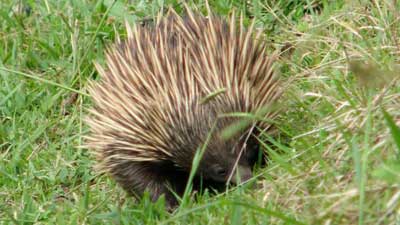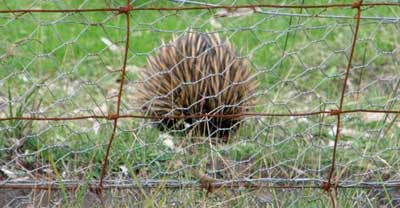
Last year I was delighted by seeing two quite different echidnas here at the same time. One had been in my yard, the other just outside it. One was big, one small, one dark, one lighter.
Lately I have had an echidna doing a very thorough job of poking into my whole house yard. Each day I have seen it in a different area, getting about at a great pace. I have had to keep an eye out when sitting weeding for any length of time as it’s given me a few shocks by silently turning up quite close to me. I wouldn’t want to step on it!
It has golden brown spikes and medium brown fur and has been putting its snout into the air more than I’d seen before.

Perhaps the reason was the proximity of another echidna, as the other day, after taking some photos of my regular one, I spotted a darker one ambling along just outside the fence. It came under the gate and began its beat.

This one has darker reddish-pink spines and very dark ‘roots’ showing in between; the fur seems blackish rather than brown.
They kept their distance but traversed sections of grass well within sight of each other, seemingly having no problem sharing territory.
Seen together like this, their differences are obvious, and I have taken to calling my regular the blonde and the visitor the brunette.
So far the blonde has been the more conscientious, not missing a day aerating my damp ‘lawn’ whilst feeding. The brunette, contrary to popular opinion, is more flighty, and comes and goes at will.
Hi Sandra, Thanks for all that info on the ticks. And yes, I know of Dr Rismiller’s work; I mentioned it in ‘Woman on the Mountain’ and there is a link on my site here to her Pelican Lagoon Research Centre.
I recently had the privilege and pleasure of attending a one day course on echidnas with Dr Peggy Rismiller. She has studied echidnas on Kangaroo Island for 2O years and was the most amazing speaker. I know that they were trying to organise a workshop near Braidwood in NSW keep an eye out for it. A non-wildlife carer friend of mine attended and enjoyed it immensely.
The ticks that you see on the echidnas also occur on wombats. We are preparing three hand raised ones for release at the moment and they get them in the yard. They don’t seem concerned by them but we do treat them before release as they are compromised by orphaning and hand-raising.
AS we don’t get paralysis tick here it may be bush ticks haemaphysalis longicornis
although both look similar to me, at least.
My experience with wombies is that they don’t cause a major problem although I can’t resist the urge to take them off – my husband thinks it’s a ‘girl thing’.
If there is a heavy tick burden it is often because the animal has an underlying condition which is weakening their immune system. A normal parasite load can be dealt with (whatever normal is) but whenever the animal is unwell the parasite burden becomes much heavier.
No I haven’t Denis but I will try to creep up and zoom in closer next time and see.
Hi Sharyn
You are very lucky to have regulars.
I see them only occasionally.
Have you noticed if they have large grey ticks near their eyes?
Whenever I have seen them up close, they have had ticks. But the ticks seem not to trouble them. After all, they have had plenty of time to evolve a resistence to tick venom.
Cheers
Denis